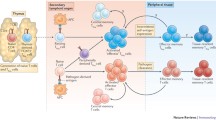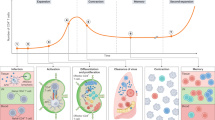Abstract
Immunologic memory refers to the dramatic response to previously encountered antigen (Ag) that is largely controlled by CD4 T cells. Understanding how CD4 memory is regulated isessential for exploiting the immune system to protect against disease and to dampen immunopathology in allergic responses and autoimmunity. Using defined adoptive-transfer models, we are studying parameters that affect differentiation of memory CD4 cells in vivo and have found that a complex interplay of T cell receptor signaling, costimulation, and cytokinesc an determine the extent of memory development and the balance of Th1 and Th2 memory subsets. On challenge, memory CD4 cells localize in sites of Ag exposure and develop into effectors that regulate memory responses. We are investigating the roles of adhesion molecules, cytokines, and chemokines in the selective recruitment of CD4 memory subsets to address mechanisms by which memory T cells provide long-lasting immunity and, in our recent studies, to determine how memory CD4 cells contribute to the development of autoimmune diabetes.
Similar content being viewed by others
References
MacLennan ICM, Gulbranson-Judge A, Toellner KM, et al.: The changing preference of T and B cell for partners as T-dependent anti-body responses develop. Immunol Rev 1997;156:53–66.
Bradley LM, Watson SL: Lymphocyte migration into tissue: the paradigm derived from CD4 subsets. Curr Opin Immunol 1996;8: 312–320.
Cyster JG: Chemokines and the homing of dendritic cells to the T cell areas of lymphoid organs. J Exp Med 1999;189:447–450.
Pape KA, Khoruts A, Mondino A, et al.: Inflammatory cytokines enhance the in vivo clonal expansion and differentiation of antigen-activated CD4+T cells. J Immunol 1997;159:591–598.
O'Garra A: Cytokines induce the development of functionally beterogeneous T helper subsets. Immunity 1998;8:275–283.
Zinkernagel RM, Bachmann MF, Kundig TM, et al.: On immunological memory. Annu Rev Immunol 1996;14:333–367.
Van Parijs L, Refacli Y, Lord JD et al.: Uncoupling IL-2 signals that regulate T cell proliferation, survival, and Fas-mediated activation-induced cell death. Immunity 1999;11:281–288.
Boise LH, Minn AJ, Noel PJ, et al.: CD28 costimulation can promote T cell survival by enhancing the expression of Bc1-x1. Immunity 1995;3:87–98.
Saparov A, Wagner FH, Zheng R, et al.: Interleukin-2 expression by asubpopulation of primary T cells is linked to enhanced memory/effector function. Immunity 1999; 11:271–280.
Reiner SL, Seder RA: Dealing from the evolutionary pawnshop: how lymphocytes make decisions. Immunity 1999;11:1–10.
Agarwal S, Rao A: Modulation of chromatin structure regulates cytokine gene expression during T cell differentiation. Immunity 1998;9:765–775.
Ahmed R, Gray D: Immunologic memory and protective immunity: understanding their relation. Science 1996;272:54–60.
Swain SL: Generation and in vivo persistence of polarized Th1 and Th2 memory cells. Immunity 1994;1:543–552.
McHeyzer-Williams LJ, Panus JF, Mikszta JA, et al.: Evolution of antigen-specific T cell receptors in vivo: preimmune and antigen-driven selection of preferred complementarity-detemining region 3 (CDR3) motifs. J Exp Med 1999; 189:1823–1837.
Swain SL, Hu H, Huston G: Class II-independent generation of CD4 memory T cells from effectors. Science 1999;286: 1381–1383.
Garside P, Inguilli E, Merica RR, et al.: Visualization of specific B and T lymphocyte interactions in the lymph node. Science 1998; 281:96–99.
Linton PJ, Harbertson J, Bradley LM: Optimal CD4 memory requires B cell as antigen presenting cells. J Immunol 2000, in press.
Guery JC, Ria F, Adorini L: Dendritic cells but not B cells present antigenic complexes to class II-restricted T cells after administration of protein in adjuvant. J Exp Med 1996;183:751–757.
Cyster JG, Goodnow CC: Antigen-induced exclusion from follicles and anergy are separate and complementary processes that influence peripheral B cell fate. Immunity 1995;3:691–701.
Ingulli E, Mondino A, Khoruts A, et al.: In vivo detection of dendritic cell antigen presentation to CD4+ T cells. J Exp Med 1997;185: 2133–2141.
Opferman JT, Ober BT, Ashton-Rickardt PG: Linear differentiation of cytotoxic effectors into memory T lymphocytes. Science 1999;283:745–748.
Barnden MJ, Allison J, Heath WR, et al.: Defective TCR expression in transgenic mice constructed using cDNA-based α- and β-chain genes under the control of heterologous regulatory elements. Immunol Cell Biol 1998;76:34–40.
Sousa CR, Hieng S, Scharton-Kerston T, et al.: In vivo microbial stimulation induces rapid CD40 ligand-independent production of interleukin 12 by dendritic cells and their redistribution to T cell areas. J. Exp. Med. 1997;186: 1819–1829.
Maldonado-Lopez R, DeSmedt T, Michel P, et al.: CD8α+ and CD8α− subclasses of dendritic cells direct development of distinct helper T cells in vivo. J Exp Med 1999;189:587–592.
van Essen D, Kikutani H, Gray D: CD40 ligand-transduced costimulation of T cells in the development of helper function. Nature 1995; 378:620.
Constant SL, Bottomly K: Induction of Th1 and Th2 CD4+ T cell responses: the alternative approaches. Annu Rev Immunol 1997;15:297–322.
Croft M, Bradley LM, Swain SL: Naive versus memory CD4 T cell response to antigen: memory cells are less dependent on accessory cell costimulation and can respond to many antigen-presenting cell types including resting B cells. J Immunol 1994;152:2675–2685.
Bradley LM, Harbertson J, Watson SR: Memory CD4 cells do not migrate into peripheral lymph nodes in the absence of antigen. Eur J Immunol 1999;29:3273–3284.
Westermann J, Pabst R: How organ-specific is the migration of ‘naive’ and ‘memory’ T cells. Immunol Today 1996;17:278–282.
Tietz W, Allemand Y, Borges E, et al.: CD4+ T cells migrate into inflamed skin only if they express ligands for E- and P-selectin. J Immunol 1998;161:963–970.
Bradley LM, Duncan DD, Yoshimoto K, et al.: Memory effectors: a potent, IL-4 secreting helper T cell population that develops in vivo after restimulation with antigen. J Immunol 1993;150: 3119–3130.
Sacca R, Cuff CA, Ruddle NH: Mediators of inflammation. Curr Opin Immunol 1997;9:851–857.
Ward SG, Bacon K, Westwick J: Chemokines and T lymphocytes: more than an attraction. Immunity 1998;9:1–11.
Sallusto F, Lenig D, Mackay CR, et al.: Flexible programs of chemokine receptors expression on human polarized T helper 1 and 2 lymphocytes. J Exp Med 1998; 187:875–883.
Bradley LM, Asensio VC, Schioetz LK, et al.: Islet-specific Th1 but not Th2 cells secrete multiple chemokines and promote rapid induction of auto immune diabetes. J Immunol 1999;162:2521–2529.
Delovitch TL, Singh B: The nonobese diabetic mouse as a model of autoimmune diabetes: immunedys-regulation gets the NOD. Immunity 1997;7:727–738.
Katz JD, Wang B, Haskius K, et al.: Following adiabetogenic T cell from genesis through pathogenesis. Cell 1993;1089–1100.
Mueller R, Bradley LM, Krahl T, et al.: Mechanism underlying counter regulation of autoimmune diabetes by IL-4. Immunity 1997;7:411–418.
Author information
Authors and Affiliations
Rights and permissions
About this article
Cite this article
Bradley, L.M., Harbertson, J., Freschi, G.C. et al. Regulation of development and function of memory CD4 subsets. Immunol Res 21, 149–158 (2000). https://doi.org/10.1385/IR:36:1:149
Issue Date:
DOI: https://doi.org/10.1385/IR:36:1:149




